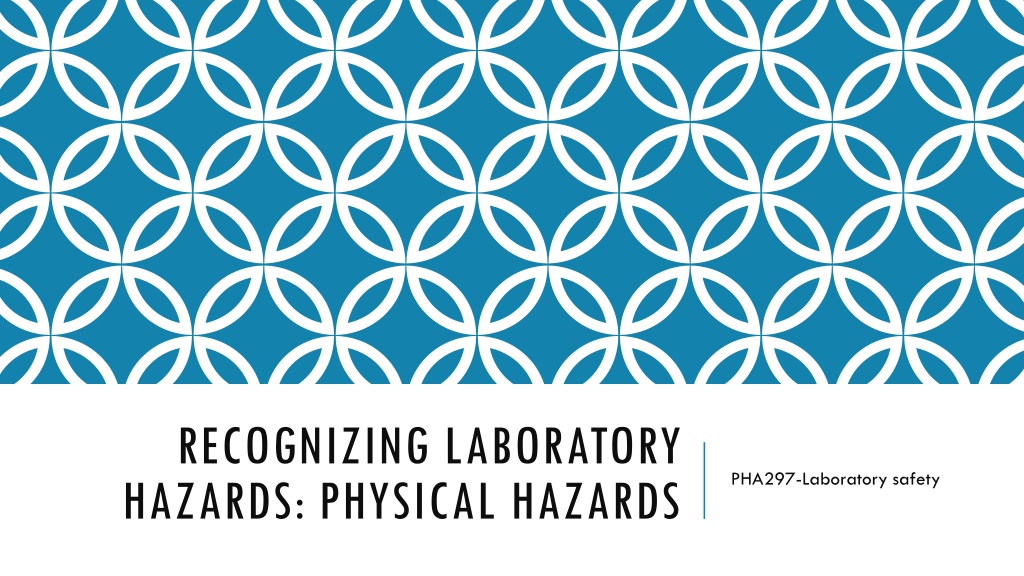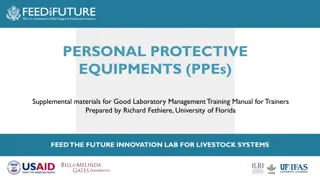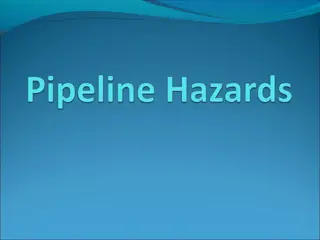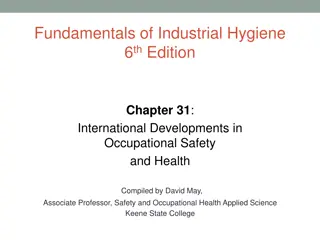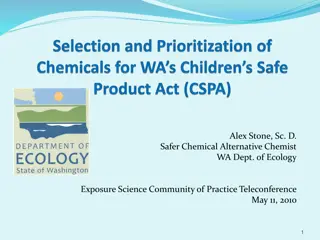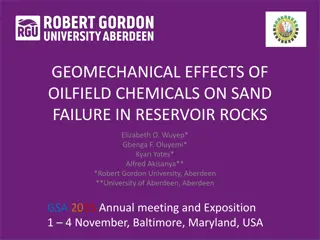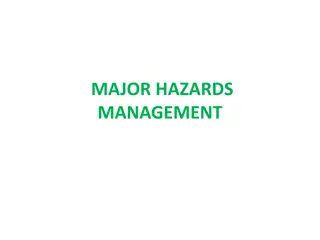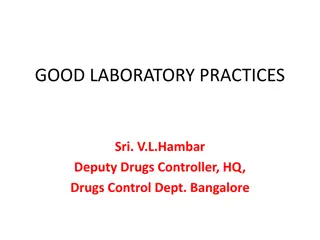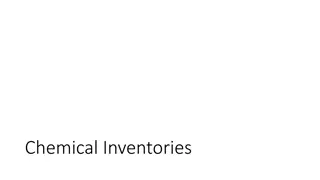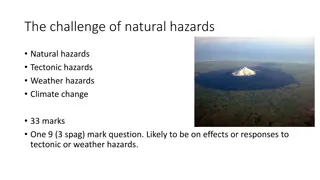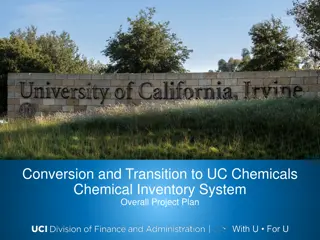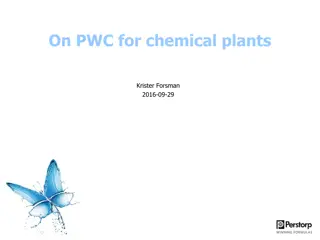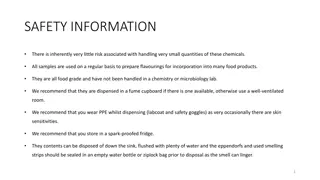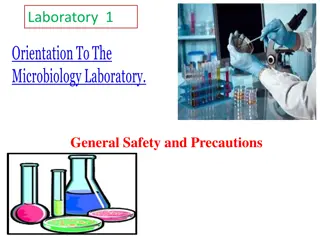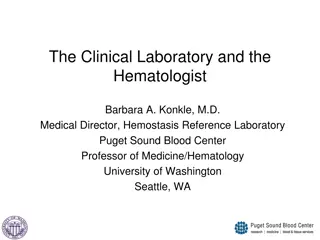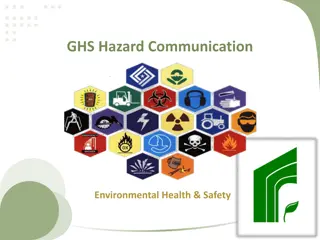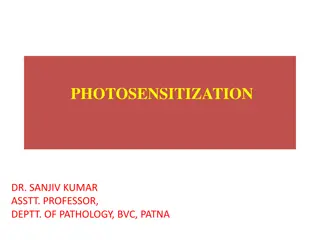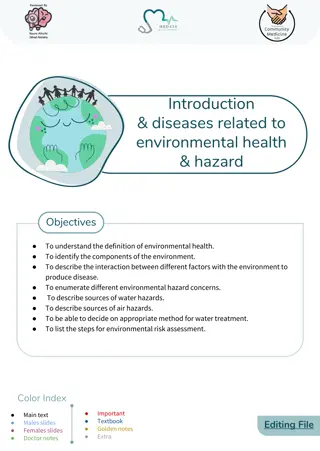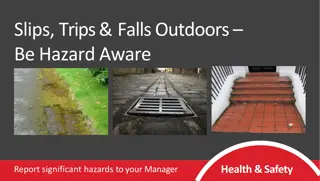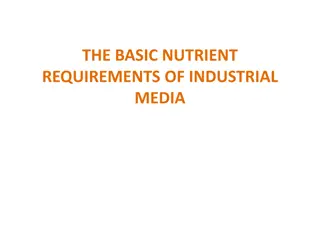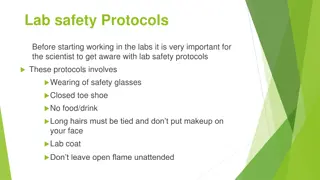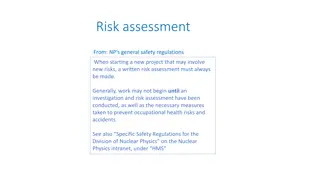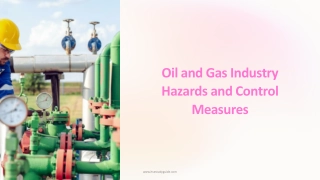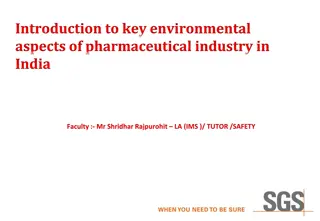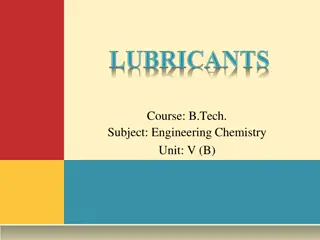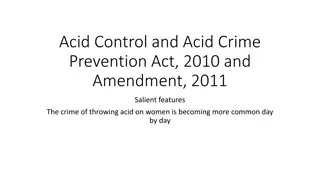Recognizing Laboratory Hazards: Physical Hazards and Corrosive Chemicals
Laboratory hazards, particularly physical hazards and corrosive chemicals, pose risks to individuals working in laboratory settings. Corrosives, such as acids, bases, oxidizing agents, and gases, can cause significant harm to eyes and skin. Proper precautions and handling procedures are crucial to minimize exposure and prevent injuries. This overview highlights the dangers associated with corrosive substances commonly encountered in pharmacy labs, emphasizing the importance of understanding chemical properties, concentrations, and safe handling practices.
Download Presentation

Please find below an Image/Link to download the presentation.
The content on the website is provided AS IS for your information and personal use only. It may not be sold, licensed, or shared on other websites without obtaining consent from the author. Download presentation by click this link. If you encounter any issues during the download, it is possible that the publisher has removed the file from their server.
E N D
Presentation Transcript
RECOGNIZING LABORATORY HAZARDS: PHYSICAL HAZARDS PHA297-Laboratory safety
CORROSIVE HAZARDS Corrosives are defined as chemicals that cause harm or injury by damaging and destroying tissue, such as eyes or skin, at the point of contact or the exposure site. Most common corrosives are some acids, bases, oxidizing agents and gases. Minimizing exposure is very important. Proper precautions should be used. Corrosive Chemicals that May Be Encountered in Faculty of Pharmacy Labs Acids Bases Oxidizing Agents Gases Hydrochloric acid Sodium hydroxide Hydrogen peroxide Ammonia Sulfuric acid Ammonium hydroxide Potassium permanganate Nitric acid Nitric acid Acetic acid
CORROSIVES - ACIDS The potential for injury by an acid depends on its chemical structure, the area of the exposure, the concentration of the solution, the duration of exposure, and the temperature of the solution. The greater the concentration, duration, and temperature encountered, the greater is the potential for harm. HCl, H2SO4, HNO3 Strong acids (and strong bases) in concentrations greater than 1 molar are usually corrosive. While concentrated and dilute may just sound like relative terms to describe the molarity of solutions, in acid base chemistry these have specific definitions. Concentrated means that the acid or base has the molarity of saturated solutions. Dilute is a less well-defined term and means that the concentration is lower than concentrated. This could be 6 M, 1 M, or less. So, while a dilute solution may sound like a safe one, 6 M is still pretty concentrated and probably quite hazardous. Acids generally cause damage to proteins, forming a substance called coagulum. As this substance accumulates it can block or prevent further damage to underlying tissues. This is why acids may be less damaging than bases, but nevertheless all corrosives have the potential to be very damaging. When diluting an acid, you should always pour acid into water. While the reverse process, pouring water into acid, may sound like an equivalent procedure, it is not.
CORROSIVES - ACIDS Since acetic acid is a weak acid (Ka = 1.7 10 5) and you probably know it also as the principal component of vinegar, it may seem to be a reasonably safe compound. In low concentrations it is. However, acetic acid is sometimes used in its glacial form that is 99.8% acetic acid. Not only is acetic acid at concentrations >50% flammable (which is not a common danger associated with most acids), glacial acetic acid has a very high affinity for water and is a strong dehydrating agent. The exothermicity of this reaction is sufficient to cause burns. Vapors of glacial acetic acid are understandably quite dangerous if inhaled. Phosphoric acid is a weak acid (Ka1 = 7 10 3) but can also be found in pure, 100% form. Phosphoric acid is also known as ortho-phosphoric acid and it solidifies below 21 C. It is hygroscopic and a strong corrosive. In high concentrations it can cause severe burns to the skin. At lower concentrations it is an irritant. While phosphoric acid as a mist can be irritating to the eyes, nose, throat, and respiratory system, it is unlikely to cause pulmonary edema. While all acids are very hazardous in concentrated form, hydrofluoric acid (HF) is extremely hazardous, and HF solutions 0.01 molar concentrations are very corrosive. While you are not likely to encounter HF in your early laboratory sessions, you should know something of its especially hazardous nature and that it requires special treatment upon exposure. HF solutions must be handled with great care, and exposures to HF require special attention with flushing for only 5 minutes rather than the normal 15 minutes, then immediate, specific medical treatment, typically with benzalkonium chloride (Zephiran) or calcium gluconate. No work should be done with HF unless these pharmaceuticals for treating HF burns are present, are readily available to the laboratory or to a nearby medical clinic or hospital, and a plan has been made with medical staff to treat these HF burns in the event of an exposure.
CORROSIVES - BASES NaOH (caustic soda), KOH (caustic potash) - highly corrosive They are mostly in pellet form and both liquid and solid forms are extremely corrosive and exposure can cause severe burns. Dissolving these hydroxide pellets in water generates a lot of heat, and a hot corrosive can be even more hazardous. If you have some of these pellets in the palm of your hand, they will quickly absorb moisture from your hand and/or the air and can generate a very concentrated (saturated) solution. Ammonium hydroxide, another base commonly used in the laboratory, is a weaker base than the alkali bases, but at high concentrations is also highly corrosive and irritating to the skin, eyes, and mucous membranes. Additionally, ammonia gas is released from ammonia hydroxide solutions and this ammonia can be very irritating to the eyes and mucous membranes.
NaOH CORROSIVES - BASES In general, bases can cause severe damage because exposures may not be immediately painful, but harmful reactions with body tissues begin immediately if they are not removed immediately from the skin or point of contact. Bases act in a different way than do acids. Hydroxide ions saponify (break up) fats and proteins, and the bases continue to penetrate deeper into the skin or site of exposure, causing damage unless they are consumed or thoroughly washed away. We previously discussed how acids initially damage tissue, but the damaged tissue eventually forms a protective layer that prevents further damage. However, damage by bases does not form protective layers, so corrosive action continues until the base is washed away or used up. Furthermore, bases are not easily removed and it takes continuous washing for some time to remove them. The key here is to prevent exposure, but if you are exposed, you must take action quickly to avoid tissue damage.
EYE EXPOSURE The eye is especially susceptible to severe damage from exposure to corrosives. The concentration and length of exposure determine the amount of damage or injury. The eye is resistant to changes from solutions in the range of pH 3 10; however, outside this pH range (<pH 3 or >pH 10), the eye s epithelium is rapidly destroyed. Eye exposure to concentrated sulfuric acid can be extremely serious due to the affinity of sulfate ions for corneal tissue, its dehydrating effect, and its high heat of hydration. Reducing exposure time is critical to prevent permanent damage or blindness every second is important. Any exposure of base or acid should immediately be treated with thorough washing with water for at least 15 minutes, followed by an immediate examination by a physician in a nearby clinic or hospital emergency room.
CORROSIVES CAN BE INHALED Some corrosive chemicals pose hazards via the inhalation route in gaseous, fume, mist, or powder forms that can cause damage to mucous membranes or lung tissue. Although they are not common in pharmacy education labs, it is good to know the hazards of them. These gases can be inhaled and can cause severe damage to skin, eyes, nose, and the sensitive lining of the lungs that in some cases can lead to delayed fluid buildup in the lungs called pulmonary edema a dangerous medical condition that can be fatal. Cu(s) + 4HNO3(aq) Cu(NO3)2(aq) + 2NO2(g) + 2H2O(l ) There are two corrosive substances to be aware of here: a reactant, strong nitric acid, and a product, gaseous nitrogen dioxide. This red gas is a strong oxidizing agent and will react with water (moisture) in your lungs to produce nitric acid. Brief exposure to as little as 250 ppm will cause frothy sputum, difficulty breathing, and increased respiration and heart rates. And these symptoms may persist for 2 3 weeks. (In nonlab settings, NO2 is a main component of smog in urban areas although concentrations are closer to 0.1 ppm. The main source of NO2 is automobile engine exhaust. Catalytic converters use elemental rhodium to reduce the NO2 to N2) Any reaction producing NO2should be conducted in a chemical hood.
CORROSIVES CAN BE INHALED NH3(aq) + H2O(l) NH4+ (aq) + OH (aq) And the dissolved ammonia is in equilibrium with the vapor over the surface of the liquid: NH3(aq) NH3(g) Henry s law describes the solubility of a gas in water as a function of the partial pressure of the gas over the surface of the solution. It is described by the equation S = kHP where S is the solubility of gas (as molarity), P is the partial pressure of the gas over the surface of the solution, and kH is the Henry s law constant for a particular gas. We can use Henry s law to calculate the vapor pressure of ammonia over the surface of solutions of ammonium hydroxide. The Henry s law constant for ammonia is 58 atm/M. Let s assume that we are using 6 M NH4OH: P = S /kH = (6 M)/(58 M/atm) = 0.1 atm A concentration of 0.1 atm is equal to 100,000 ppm. The IDLH (immediately dangerous to life or health) value for ammonia is 300 ppm. So if we take a good strong whiff of the vapor over the surface of 6 M ammonia, we are smelling ammonia at over 300 times the IDLH value! But one whiff is not 30 minutes. Alternatively, we can look at the LClo for mammals, which is 5000 ppm for 5 minutes. This is the lowest concentration known to cause death. So, if we are breathing 100,000 ppm we are breathing 20 times the concentration that is lethal in 5 minutes for mammals. All of this should convince you to use 6 M NH3 (and other high-concentration ammonia/ ammonium hydroxide solutions) in a chemical hood! Even though it is a solution, the vapor over the surface of this solution is quite harmful.
OXIDIZING AGENTS Nitric acid is probably the oxidizing agent that you are most likely to use and we ve already discussed this in the consideration of strong acids! So, it can be dangerous in two fashions. Its corrosive effect is due mainly to its oxidizing power, in fact, more so than its capability as a strong acid. In fact, nitrate salts such as KNO3 and NH4NO3are also good oxidizing agents. It s the nitrate that is the oxidizing species. Hydrogen peroxide is another common oxidizing agent. It is also a fairly common household chemical that can be used for disinfecting wounds (3%) or decolorizing hair (15%). Laboratory solutions can be as high as 30%, which is extremely corrosive. The by-product of this oxidizing agent is water, which makes it convenient to use. Solutions with a concentration of > 8% are considered corrosive. Some laboratory titrations are conducted using potassium permanganate (KMnO4) since it is a strong oxidizing agent and the disappearance of the purple permanganate acts as an endpoint indicator. Dilute solutions that you are likely to use are only mildly irritating to the skin but high concentrations and the solid salts are very corrosive. The bottom line here is that any good oxidizing agent will likely be able to oxidize you, too! Your skin and eyes will become the targets of these oxidizing agents unless appropriate precautions are taken.
FLAMMABLES Flammable chemicals are chemicals that easily ignite and rapidly burn, releasing large amounts of energy, mostly in the form of heat. (Sometimes you see the term inflammable it is a synonym of flammable.) Once ignited, they continue to burn as a self-sustaining reaction until the chemical is consumed or it is extinguished. Indeed, they have a passion for burning, and they come in all forms: gases, liquids, and even solids. Combustible chemicals become flammable if they are heated so that they give off sufficient vapors to be easily ignited. While combustibles are more difficult to ignite, once ignited they also readily burn. The boiling point of a flammable liquid is usually relatively low. The flash point of a chemical is the lowest temperature at which its vapors near the liquid surface can be ignited under controlled conditions. For a liquid this is the lowest temperature at which vapors,above its surface mixing with air, can form an ignitable mixture. The autoignition temperature is the temperature at which a flammable chemical ignites in air spontaneously under controlled conditions. The lower the autoignition temperature, the greater the potential risk for a fire. Autoignition temperatures are generally quite high,
FLAMMABLES Each chemical has a range of concentrations of its vapors called flammability limits within which a fire or explosion can occur, while fires will not occur below or above those limits. The lower explosive limit (LEL), sometimes called the lower flammability limit (LFL), is the lowest concentration of vapor in air, expressed in percent by volume, at which a fire can be started resulting in an explosion, when a source of ignition is present. Below the LEL, the concentration of the vapor is insufficient to support burning. The upper explosive limit (UEL), sometimes called the upper flammability limit (UFL), is the highest concentration of vapor in air expressed in percent by volume, at which a fire will be propagated. Above this limit the concentration of the vapor is too high to support burning. These limits become wider as temperatures are increased and as oxygen content is increased. The result of these variations in LEL and UEL is that flammability limits are not very useful. For example, when a flammable liquid is spilled its LEL is quickly achieved as the broad surface allows large amounts of chemical to vaporize, and if this occurs within the presence of an ignition source a fire or explosion can occur
FLAMMABLES Fire Hazard Rating Systems The United Nation s Globally Harmonized System (GHS) defines flammable and combustible liquids in terms of measurable chemical properties. This hazard rating system uses a 1 for the highest level of flammability hazard and a 4 for the lowest level of flammability hazard. Properties of Flammable and Combustible Liquids as Defined by the Globally Harmonized System for Classification and Labelling of Chemicals
FLAMMABLES Laws require that flammable chemicals be labeled as such. The GHS has devised a hazard class (HC) rating system that includes flammables and this system can help you recognize the relative flammable hazard of a chemical. These ratings range from HC 1 to HC 4 with HC 1 being extremely flammable and HC 4 being combustible liquids. Mostly, flammability is strongly related to volatility but there are also nonflammable volatile chemicals. Molecular structure affects flammability. Why Are Fires So Dangerous? There are three main effects from a fire that are dangerous: heat released, toxic by-products from the combustion, and oxygen consumed.
INCOMPATIBLES Incompatible chemicals are combinations of substances, usually in concentrated form, that react with each other to produce very exothermic reactions that can be violent and explosive and/or can release toxic substances, usually as gases.
Strong Oxidants and Reductants These compounds are imcompatible with many others as they react with them by producing high amount of energy. The most commons are nitric acid and nitrate, perchloric acid, permanganate and hydrogen peroxide. INCOMPATIBLES Water-reacting compounds We ordinarily consider water to be fairly nonreactive. Water-reactives are chemicals that react violentlywith water, releasing large amounts of heat and sometimes flammable gases or toxic gases, often resulting in fires or explosions Examples of Water-Reactive Classes of Compounds
